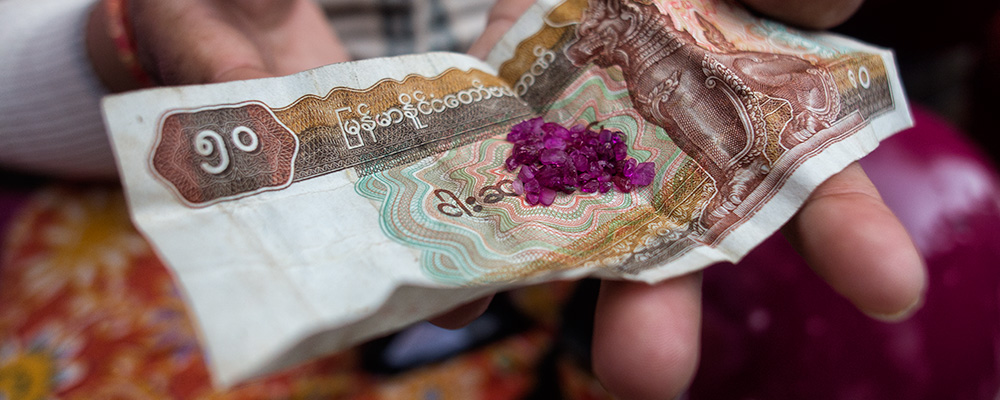A look at the geology of Myanmar's Mogok Stone Tract, home to pigeon's blood rubies and so much more…
The Mogok Stone Tract is situated in Myanmar’s Mandalay province, some 200 km northeast of Mandalay. Home to the world’s premier ruby mines, it is also one of the richest mineral concentrations on Earth. Aside from ruby, Mogok produces a potpourri of gems, including sapphire, spinel, peridot, topaz and moonstone, to name but a few. One of Mogok’s gems, painite, is found nowhere else on the planet. With over fifty different gem species mined at Mogok, in terms of gemological diversity, perhaps only Sri Lanka can compare.
Bend me, stretch me…
During certain periods in the Earth’s history, tectonic activity produced large-scale deformation of the surface. This stress resulted in fantastic zones of mineral formation, where mundane minerals mutated into artistic wonders of singular beauty. Geologists call this rock recycling process “metamorphism” and the resulting bow-shaped regions “orogenic” belts. Most of the world’s greatest ruby and sapphire mines fall into one of two such zones.
The Pan-African orogeny (Figure 1) occurred 750–450 million years ago, and gave rise to deposits in Kenya, Tanzania, Mozambique, Madagascar, Sri Lanka and southern India. Many of these corundums are genetically related.
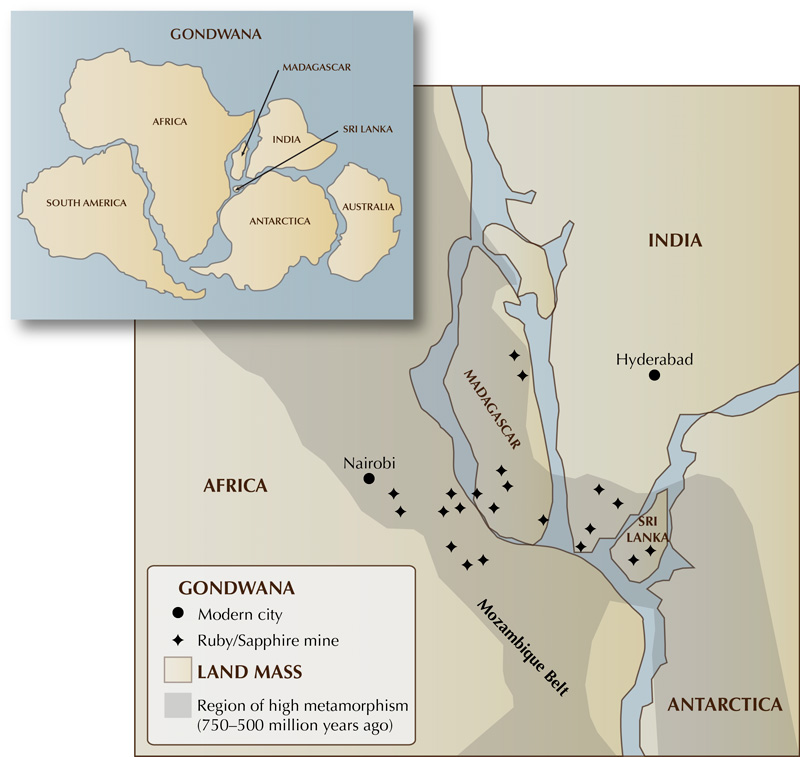 Figure 1. The former supercontinent, Gondwana, showing the proximity of the important ruby and sapphire deposits of East Africa, Madagascar, Sri Lanka and southern India some 750–500 million years ago. From Hughes et al., 2014.
Figure 1. The former supercontinent, Gondwana, showing the proximity of the important ruby and sapphire deposits of East Africa, Madagascar, Sri Lanka and southern India some 750–500 million years ago. From Hughes et al., 2014.
In contrast, the Himalayan orogeny took place just 45–5 million years ago, a result of the Indian subcontinent speeding north from Gondwana and colliding with the Asian plate (Figure 2). In geologic terms, this was a continental train wreck as India dove some 2000 km under and into Central Asia. This resulted in not just the greatest mountains on the planet, but furious mineral-forming activity, including a string of ruby and sapphire deposits that stretch all the way from Afghanistan and Tajikistan in Central Asia, through Pakistan, northern India, Nepal and Myanmar, to China and Vietnam in the East. Together with the Pan-African orogeny, these two events are responsible for virtually all of the finest rubies and sapphires thus far discovered on Planet Earth.
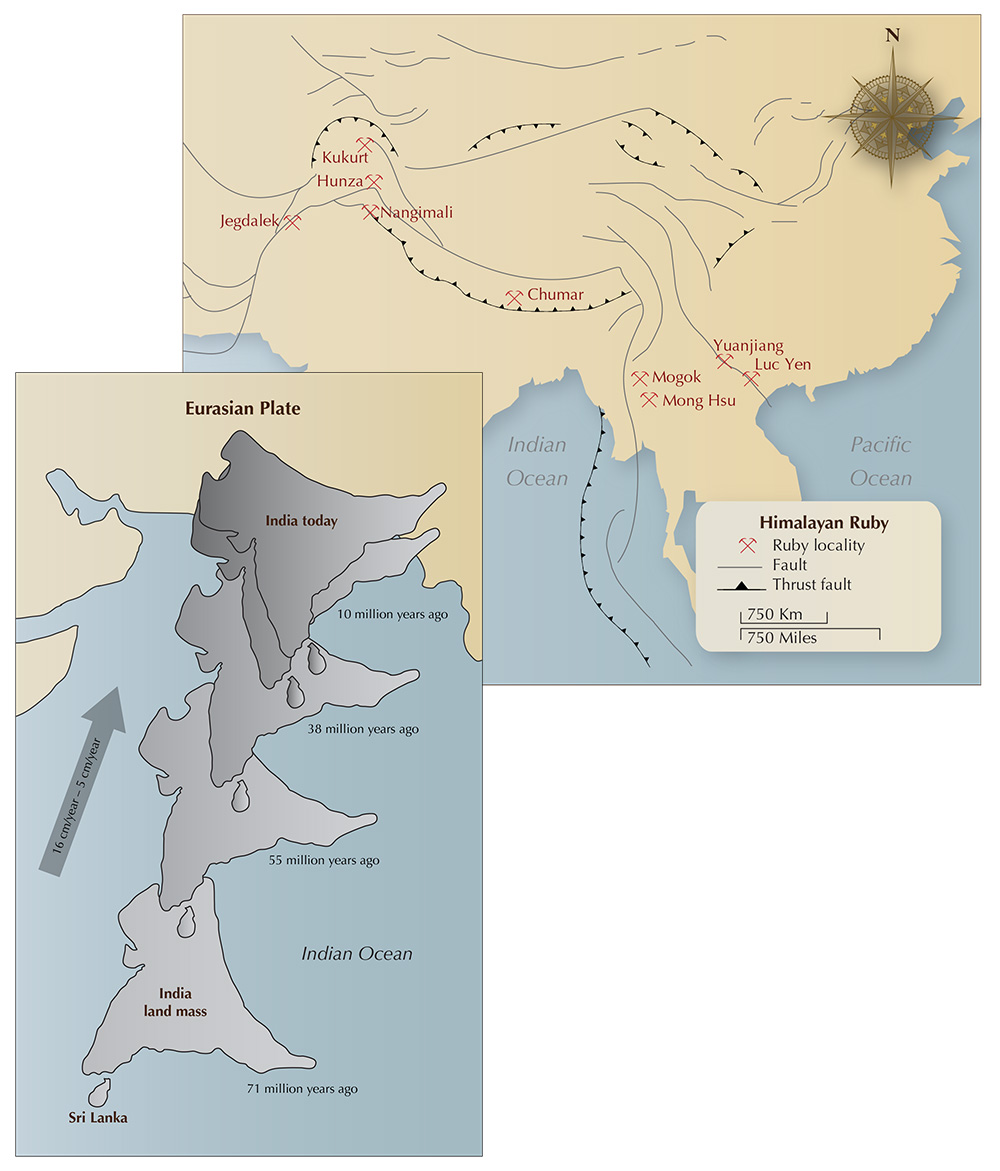 Figure 2. South and Central Asia, showing the major faults associated with the collision between the Indian subcontinent and the Eurasian mainland. One of the results was the formation of ruby, as limestone metamorphosed into marble, creating the world’s premier ruby deposits. From West to East: Jegdalek (Afghanistan), Kukurt (Tajikistan), Hunza and Nangimali (Pakistan), Chumar (Nepal), Mogok and Mong Hsu (Burma), Yuanjiang (China) and Luc Yen (Vietnam). The Himalayan orogeny took place during the period between 45–5 million years ago, making these rubies more than ten times younger than their Mozambique belt cousins. From Hughes et al., 2014.
Figure 2. South and Central Asia, showing the major faults associated with the collision between the Indian subcontinent and the Eurasian mainland. One of the results was the formation of ruby, as limestone metamorphosed into marble, creating the world’s premier ruby deposits. From West to East: Jegdalek (Afghanistan), Kukurt (Tajikistan), Hunza and Nangimali (Pakistan), Chumar (Nepal), Mogok and Mong Hsu (Burma), Yuanjiang (China) and Luc Yen (Vietnam). The Himalayan orogeny took place during the period between 45–5 million years ago, making these rubies more than ten times younger than their Mozambique belt cousins. From Hughes et al., 2014.
While marble-hosted ruby deposits have been studied in some detail elsewhere (Garnier et al., 2008), political instability has left Myanmar’s mines as somewhat of an enigma.
All across the Himalayan belt, ruby is found in marble. According to Harlow and Bender (2013):
The present model for the formation of rubies hosted in marble from the Himalayan arc is a closed-system metamorphism of former clays from evaporitic/organic-rich shale units in margin basins. Mogok has still not been fully included in this model. Involvement of igneous intrusions and the formation of skarn with the marble has been an outstanding topic.
In plain English, an ocean (the Tethys Sea) once separated the Indian subcontinent from Asia. Oceans are typically filled with sea creatures whose skeletons are rich in calcium and carbon. As fish and coral die, those bones end up in sediments on the sea’s floor, eventually forming a sedimentary rock we call limestone.
When the Indian subcontinent slammed into Asia, this former seafloor was raised up, in places so high that bits of it can be found even on the summit of Mount Everest. Extreme pressures from this collision caused recrystallization of the limestone into a metamorphic rock called marble.
So now we understand how the marble formed, but where did the ruby come from? Ruby consists of aluminum (Al) joined to oxygen (Al2O3), with a dash of chromium (Cr3+). Neither aluminum nor chromium is normally present in limestone. It is thought that these elements entered the marble system when clays metamorphosed into shale at margin basins. This alteration of an otherwise pure rock by hydrothermal solutions is termed “metasomatism” and is thought to be the mechanism by which aluminum and chromium (and vanadium) entered the marble (Figure 3). [Philippe Belley notes: "It is relatively common for limestone to contain impurities of siliciclastic sediment, including clays; in fact, mixed mud-limestone rocks (marls) are interpreted to be the precursors to many sapphire and spinel occurrences on Baffin Island (Canada)."]
Marbles come in two flavors. Some are simply made of calcite – CaCO3, while others are composed of dolomite – CaMg(CO3)2. When Al and Cr join together with magnesium (Mg), the result is spinel. Only when the Mg is exhausted does ruby grow. This explains why far more red spinels than rubies are found at Mogok. [Philippe Belley notes: "Other factors can also significantly influence whether corundum or spinel forms where Mg is not a limiting reactant. For a specific reaction volume rock composition, pressure, temperature, and fluid composition (CO2 vs H2O) can dictate whether corundum, spinel, or neither are part of the stable assemblage. This is why some deposits have spinel forming at the expense of corundum or vice versa.]
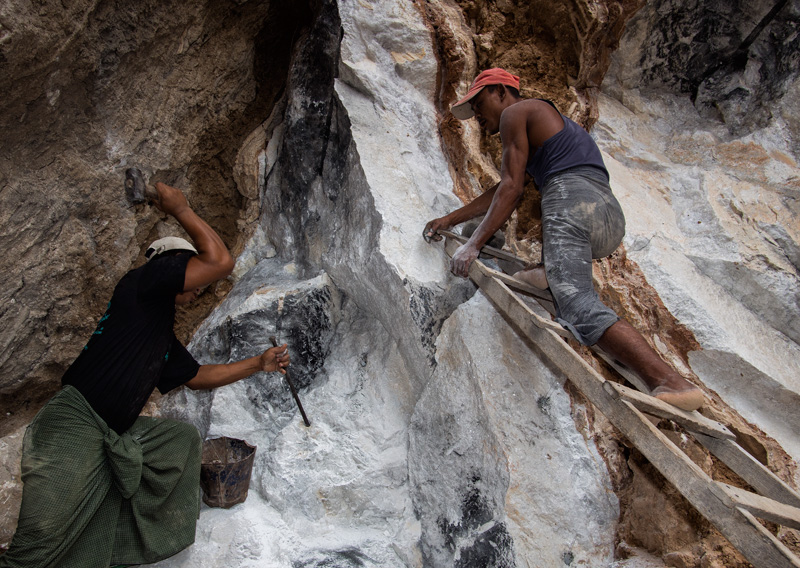 Figure 3. Ruby miners preparing to set an explosive charge in the marble at Sagyin, just north of Mandalay. Note the clay band cutting through the marble. Hydrothermal fluids from this clay are thought to have supplied the aluminum and chromium necessary for the growth of ruby and spinel in marble. Photo: E. Billie Hughes
Figure 3. Ruby miners preparing to set an explosive charge in the marble at Sagyin, just north of Mandalay. Note the clay band cutting through the marble. Hydrothermal fluids from this clay are thought to have supplied the aluminum and chromium necessary for the growth of ruby and spinel in marble. Photo: E. Billie Hughes
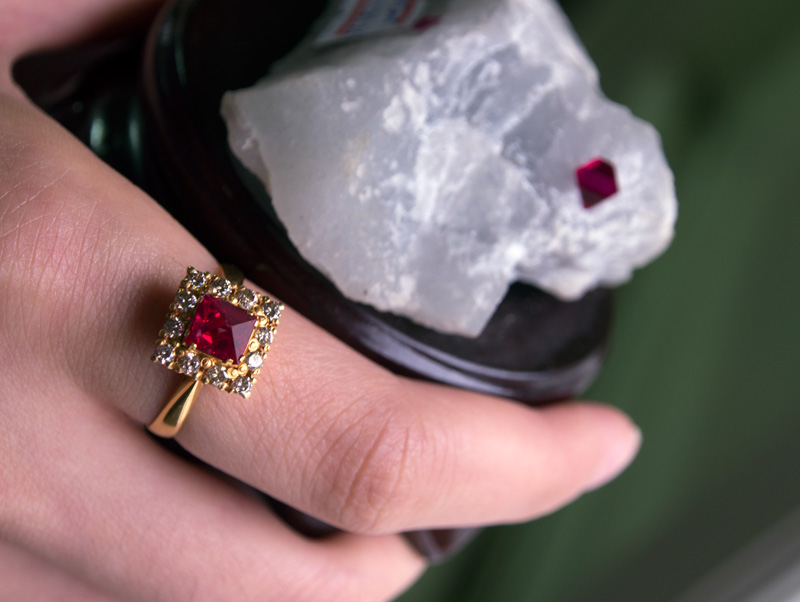 Figure 4. Ruby is not the only gem found in marble at Mogok. Spectacular red spinels are even more common. Some of these octahedral crystals are so perfect that they are termed nat-twe (angel polished). The photo shows a completely natural spinel crystal mounted in a ring, along with a natural spinel octahedron in the marble mother rock. Specimens courtesy of Dr. Saw Naung U family; Photo: Wimon Manorotkul
Figure 4. Ruby is not the only gem found in marble at Mogok. Spectacular red spinels are even more common. Some of these octahedral crystals are so perfect that they are termed nat-twe (angel polished). The photo shows a completely natural spinel crystal mounted in a ring, along with a natural spinel octahedron in the marble mother rock. Specimens courtesy of Dr. Saw Naung U family; Photo: Wimon Manorotkul
Skarn
But what’s the skarn mentioned above? In the current sense, skarn refers to a rock formed by metasomatism, where an igneous rock (such as a granite) comes in contact with a carbonate (such as a marble). And herein lies the uncertainty. The accepted geologic model for formation of ruby in marble cannot explain certain ruby specimens that have been found in the Mogok area that show evidence of having formed in a skarn. Thus much more work remains to be done before the occurrence of ruby at Mogok is fully understood.
Karst topography
One of the first things a visitor notices upon entering the Mogok region is the presence of eerie black rock pinnacles rising from the surrounding valleys and hills. That black rock is weathered marble and the weathering process in the area has produced something geologists call a “karst topography.” China’s Guilin region is perhaps the most famous example of this. It is produced by mildly acidic water dissolving the weakly soluble limestone/marble.
Breaking open one of those black rocks at Mogok will reveal a bright white marble within (and if the gods are smiling, a ruby or spinel). Mogok’s marble is extremely coarse-grained, meaning the individual calcite and dolomite crystals within the rock body are quite large, testimony to an exceedingly slow crystallization process. When a crystal grows slowly, it grows larger and with greater perfection, one of the clues as to why we find so many fine gems in the Mogok area.
Among the benefits of the processes that produce karst topography is that those same acidic waters also free the gems in the marble. Mogok is riddled with caves and narrow underground passages as millions of years of weathering have eaten away the weak places in the marble. Those gems settle in the cave bottoms; the Burmese term these places lu-dwin, and they are home to some of the richest concentrations of ruby and spinel.
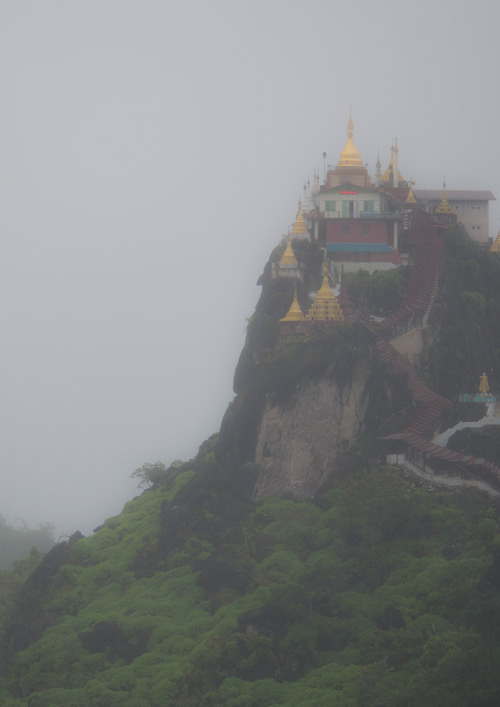 Figure 5. The karst topography of the Mogok area is on display at Kyauk-Pyat-That, where a temple sits atop weathered marble like a fairyland castle. Photo: R.W. Hughes
Figure 5. The karst topography of the Mogok area is on display at Kyauk-Pyat-That, where a temple sits atop weathered marble like a fairyland castle. Photo: R.W. Hughes
Geologic Jigsaw Puzzle
Geologically, the Mogok Stone Tract lies in what geologists call the Mogok metamorphic belt, a 40 km-wide swath stretching from Moulmein in the south to Putao, some 1450 km to the north. This belt contains a variety of andalusite and sillimanite-bearing metamorphic rocks, pre-collisional granites and granodiorites, and post-collision garnet + tourmaline-bearing leucogranites (Searle et al., 2007).
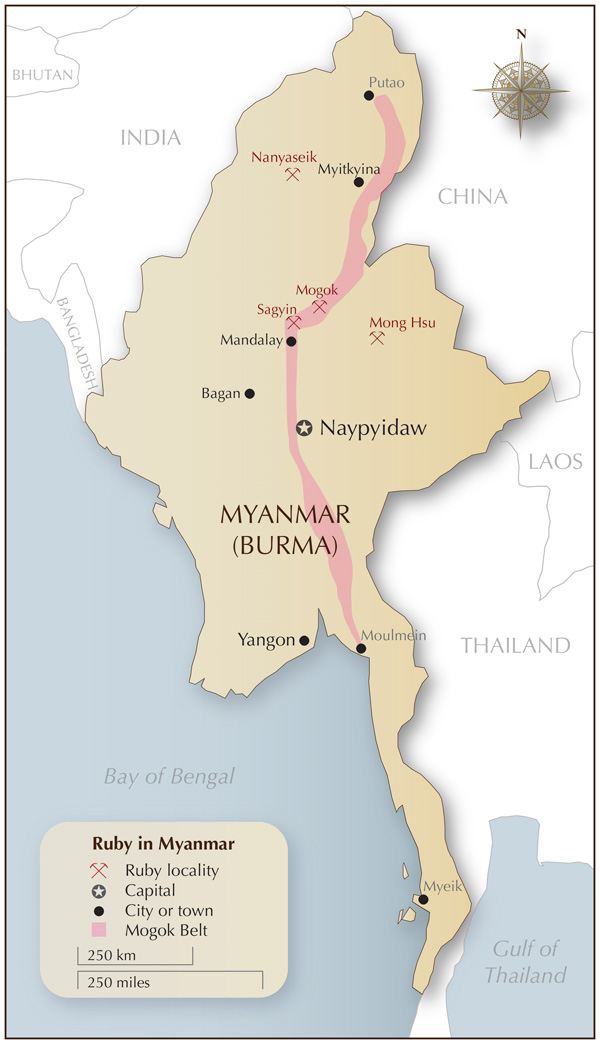 Figure 6. Map of Myanmar showing the location of Mogok and the Mogok Belt.
Figure 6. Map of Myanmar showing the location of Mogok and the Mogok Belt.
Map: Richard W. Hughes
Via phlogopite inclusions, the Mogok marble emplacement has been dated at a minimum age of approximately 18.7 million years (Garnier et al., 2006). In the Mogok area there are also schist and quartz veins cutting across the marble units.
Another important rock type is the so-called Mogok gneiss, which is composed mainly of sillimanite-garnet gneiss, in which is found patches of calc-silicate rock.
Ultramafic rocks found in Mogok include dunite and harzburgite, both featuring chromite. Pegmatite veins and graphic granite dykes cut into these ultramafic rocks (Mitchell et al., 2007).
Intrusive igneous rocks in Mogok are predominantly nepheline syenite. Dating granite in the Mogok area by 40Ar/39Ar in biotite gave a minimum emplacement age of 15.8 million years. Dating metamorphic rock using biotite revealed the age of 19.5–16.5 million years. The U-Pb dating using inclusions of zircon in ruby revealed the age to be 32–31 million years old (cited in Yui et al., 2008).
Exploration and petrogenesis studies suggest that corundum deposits in this area involve high-grade metamorphism at temperatures of about 600–650° C, with pressures of approximately 4.5 kbar (Barley et al., 2003).
Correlation studies between the metamorphic and igneous rocks reveal that there were two metamorphic processes, namely Early Jurassic regional metamorphism and Early Tertiary metamorphism. These high-grade metamorphic processes likely occurred during the collision of Indian and Eurasian plates at 65–55 million year ago. This was later followed by igneous intrusions (primarily syenite and leucogranite) during the period of 35–23 million years ago (Maung Thein, 1973; Barley et al., 2003).
Both primary and secondary deposits are mined in the Mogok area. Ruby and sapphire in such primary deposits are mainly hosted in white marble intercalated with other metasediments of the Mogok metamorphic belt. The corundum-bearing marbles are always in contact with either mica-rich granite gneiss or calc-silicate rocks.
In Mogok, certain localities produce only ruby or only sapphire, but others host both ruby and sapphire. One example of the latter is Baw Mar, where mine owner Tint Lwin told us that both ruby and sapphire are found. During our explorations at Baw Mar in July 2013, we found no evidence of the existence of both ruby and sapphire within the same marble bed. Hence, it is clear that detailed research work is required to unravel this mystery (GIT, 2013a, b).
By now it should be clear that the geology of the Mogok area is extremely complex, with formation processes including metamorphism, igneous intrusion and skarn reactions. Such processes have produced ruby-bearing marbles, sapphire-bearing pegmatites, nepheline syenites, and a host of other rocks. It’s almost as if Mother Nature took all of her leftovers and dumped them into this remote region of Myanmar. The result is a spectacular gem assemblage, unique on Planet Earth.

References
- Barley, M.E., Pickard, A.L. et al. (2003) Jurassic to Miocene magmatism and metamorphism in the Mogok metamorphic belt and the India-Eurasia collision in Myanmar. Tectonics, Vol. 22, No. 3, pp. 4-1–4-11.
- Garnier, V., Maluski, H. et al. (2006) Ar–Ar and U–Pb ages of marble-hosted ruby deposits from central and southeast Asia. Canadian Journal of Earth Sciences, Vol. 43, No. 4, pp. 509–532.
- Garnier, V., Giuliani, G. et al. (2008) Marble-hosted ruby deposits from Central and Southeast Asia: Towards a new genetic model. Ore Geology Reviews, Vol. 34, No. 1–2, pp. 169–191.
- GIT (2013a) GIT Exploring Ruby and Sapphire Deposits of the Mogok Stone Tract, Myanmar. Bangkok, Gem and Jewelry Institute of Thailand (Public Organization), git.or.th, 6 pp.
- GIT (2013b) The Study Project on Potential and Accessibility to Sources of Raw Gem Materials in ASEAN Countries (Cambodia, Laos, Myanmar, Vietnam) (In Thai), Bangkok, Gem and Jewelry Institute of Thailand (Public Organization), 176 pp.
- Harlow, G.E. and Bender, W. (2013) A study of ruby (corundum) compositions from the Mogok Belt, Myanmar: Searching for chemical fingerprints. American Mineralogist, Vol. 98, pp. 1120–1132.
- Hughes, R.W., Manorotkul, W. et al. (2014) Ruby & Sapphire: A Collector's Guide. Bangkok, Gem and Jewelry Institute of Thailand, 384 pp.
- Maung Thein (1973) A preliminary synthesis of the geological evolution of Burma with reference to the tectonic development of Southeast Asia. Geological Society of Malaysia Bulletin, Vol. 6, pp. 87–116.
- Mitchell, A.H.G., Htay, M.T. et al. (2007) Rock relationships in the Mogok metamorphic belt, Tatkon to Mandalay, central Myanmar. Journal of Asian Earth Sciences, Vol. 29, No. 5–6, pp. 891–910.
- Searle, M.P., Noble, S.R. et al. (2007) Tectonic evolution of the Mogok metamorphic belt, Burma (Myanmar) constrained by U-Th-Pb dating of metamorphic and magmatic rocks. Tectonics, Vol. 26, TC3014, 24 pp.
- Yui, T.-F., Zaw, K. et al. (2008) A preliminary stable isotope study on Mogok ruby, Myanmar. Ore Geology Reviews, Vol. 34, No. 1–2, pp. 192–199.
Acknowledgments
The authors would like to thank the following individuals for their assistance: Hpone-Phyo Kan-Nyunt of Gübelin Gem Lab for helping to organize our latest visit to Mogok in July 2013; Dr. Ei Ei, who helped guide us in Mogok; Saw Sanda Soe, who shared her stories of growing up in Mogok; Ko Ye Aung Myo, Ko Than Htwe, U Thein Htay, U Win Maung, all of Mogok. Finally, a special thank you to GIT for financial support.
About the authors
Wilawan Atichat is the former director of the Gem and Jewelry Institute of Thailand. She currently works as an advisor for the GIT Gem Testing Laboratory.
Richard W. Hughes is one of the world’s foremost experts on ruby and sapphire. The author of several books and over 170 articles, his writings and photographs have appeared in a diverse range of publications, and he has received numerous industry awards. Co-winner of the 2004 Edward J. Gübelin Most Valuable Article Award from Gems & Gemology magazine, the following year he was awarded a Richard T. Liddicoat Journalism Award from the American Gem Society. In 2010, he received the Antonio C. Bonanno Award for Excellence in Gemology from the Accredited Gemologists Association. The Association Française de Gemmologie (AFG) in 2013 named Richard as one of the Fifty most important figures that have shaped the history of gems since antiquity. In 2016, Richard was awarded a visiting professorship at Shanghai's Tongji University. 2017 saw the publication of Richard and his wife and daughter's Ruby & Sapphire • A Gemologist's Guide, arguably the most complete book ever published on a single gem species and the culmination of nearly four decades of work in gemology. In 2018, Richard was named Photographer of the Year by the Gem-A, recognizing his photo of a jade-trading market in China, while in 2020, he was elected to the board of directors of the Accredited Gemologists Association and was appointed to the editorial review board of Gems & Gemology and The Australian Gemmologist magazine. Richard's latest book, Jade • A Gemologist's Guide, was published in 2022.
Notes
First published in InColor magazine, Fall/Winter 2013, pp. 46–50. Edited slightly to incorporate comments by Philippe Belley in January 2019.

